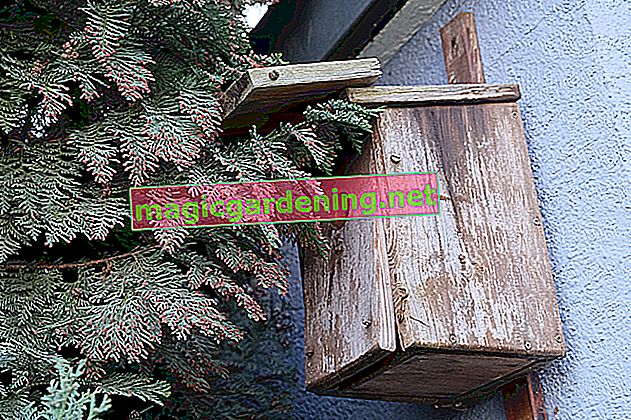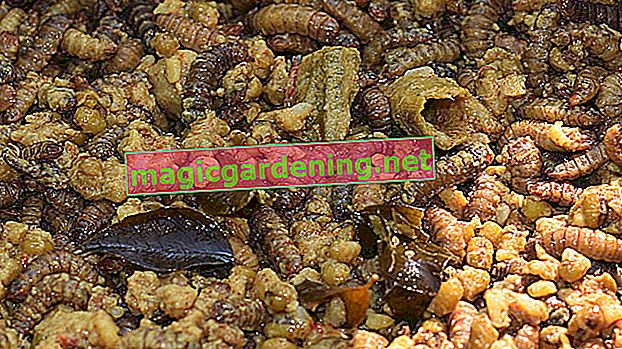
the essentials in brief
- Effective remedies against maggots in the organic bin are table salt, vinegar water, organic bin powder and slaked lime.
- Maggots in the organic waste bin arise from the eggs of blowflies, house flies and fruit flies.
- Pinworms are to be avoided if the organic waste bin with an airtight lid is in a cool, shady location and organic waste is dry, well packed and collected in an airy manner.
What helps against maggots in the organic waste bin?
Maggots in the organic waste bin pose no immediate danger to adults, children and pets. In direct contact, pinworms can transmit diseases such as tuberculosis, typhoid, wound infections and anthrax. Furthermore, the feelings of disgust associated with maggots should not be underestimated, which can cause severe nausea and vomiting in the faint of heart. The urgent desire to destroy the larvae immediately is all the more understandable. The following table summarizes what effectively helps against pinworms in the organic waste bin:
also read
- Types of maggots relevant in the garden
- Helpful home remedies for maggots
- How can maggots be fought in the garden?
| Home remedies | non-toxic agents | manual methods |
|---|---|---|
| Table salt | Organic bin powder | 3-step immediate action |
| Vinegar water | Rock flour | hairdryer |
| Bleach | Lime (slaked) | |
| Pepper water | Kieselguhr |
Has one or the other effective means aroused your interest in killing maggots as quickly as possible and without using poison? Then read on, as each procedure is explained in more detail below:
Use home remedies correctly - this is how it works
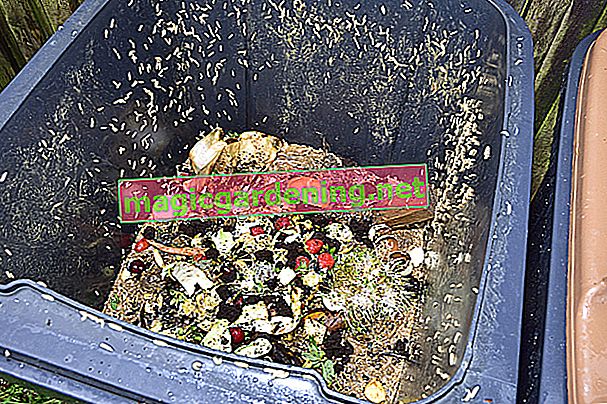
If the right home remedies are used, the days are numbered by bad maggots in the organic waste bin. The above table names the four best means by which you can successfully fight the worms. The correct application brings the following overview to the point:
- Table salt : sprinkle directly on the maggots
- Vinegar water : add 4-5 tablespoons of vinegar essence to 1 liter of water, fill into a spray bottle and spray maggots
- Bleach : stir 2-3 tablespoons of bleach into 1 liter of hot water and spray sparingly on the worms with a hand sprayer
- Pepper water: Boil 1 liter of water, stir in 3-4 tablespoons of pepper powder and use as a spray
Please note that bleach is environmentally friendly oxygen bleach. In contrast to poisonous bleaching agents with chlorine, such as the well-known disinfectant Danklorix, the use of oxygen bleach is significantly less harmful and an equally effective remedy against maggots.
Non-toxic means - tips for use
Those who do not want to plunder their stocks of salt, pepper, vinegar and bleach can use non-toxic products from the trade. Organic bin powder is one of the top 4 most effective products against maggots. The agent does not contain any insecticides, but destroys the worms on the basis of natural components. Organic bin powder is available in pharmacies, drug stores, hardware stores and numerous internet shops. The non-toxic powder kills maggots, prevents rot and reduces bad smells.
Hobby gardeners always have rock flour (€ 14.95 at Amazon *) close at hand in order to prevent the development of odors during the production of nettle manure or on the compost heap. Rock flour is less known as an effective remedy for maggots in organic waste. A thin layer of powder over each new filling is enough to put an end to malicious maggots.
If you struggle with maggots in the bio bin, please note slaked lime on the shopping list for the hardware store. Slaked lime dries out the beasts and kills them in no time. Diatomaceous earth takes on the role of a non-toxic maggot remedy just as effectively. Sprinkled directly on the writhing larvae, kieselguhr removes all moisture from the bodies. Kieselguhr is also known as diatomaceous earth and has earned a good reputation in the fight against the maggots of flour moths.
Manual methods - quick guides
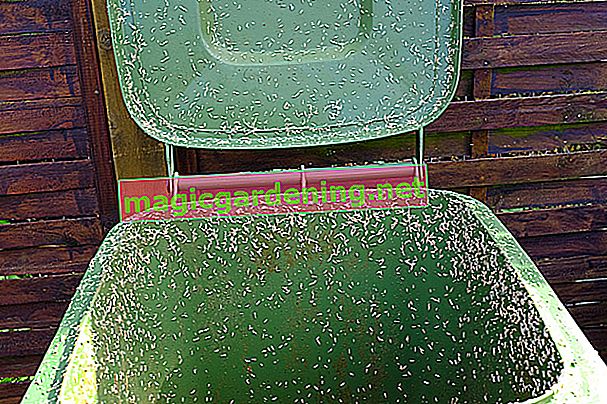
In most cases, home remedies and non-toxic products against maggots must first be brought in. Instead, roll up your sleeves and use manual methods to kill disgusting pinworms right away. The 3-step immediate action requires a courageous approach, in return it eliminates the problem immediately. The following brief instructions explain what you need and how to proceed correctly step by step:
- The best time : shortly before the next garbage collection
- Material : gloves, apron or disposable overall, rubber boots, express kettle or jug with boiling hot water, rake, high-pressure cleaner, vinegar water, sponge (€ 85.90 at Amazon *)
- Preparation : Put on gloves, rubber boots and water-repellent clothing
- Step 1 : Tip the maggot-contaminated bio-bin and pull out the contents with the rake
- Step 2 : Pour boiling water over organic waste until all maggots have been destroyed, cover with foil and allow to dry
- Step 3 : Clean the organic waste bin, fill in dried, maggot-free rubbish and put it on the street for disposal
Alternatively, you can expose the organic waste bin and its contents to strong heat from a hairdryer. Since maggots mainly consist of water, the monsters have nothing to oppose to the hot air flow and languish. At least you can fight the maggots in and on the top layers of trash this way.
Digression
Cleverly upcycling raw meat and fish scraps - 2 ideas

Leftovers of raw meat and fish are a great food for maggots in the organic waste bin. Instead of serving the worms in the organic waste a lavish fresh meat buffet, resourceful housewives and clever carpenters have developed two ideas for upcycling. Boil raw meat or fish scraps in water with a spicy stock cube to make a delicious stock. The boiled leftovers do not have any noteworthy attraction on pinworms in the organic waste bin. Meat, fish and other kitchen waste are put in a Bokashi bucket for complete recycling. With the exclusion of oxygen and the addition of Bokashi ferment, garbage is transformed into rich liquid fertilizer for your indoor plants.
How are maggots made in the organic waste bin?
Eliminating maggots leaves very few people affected without a trace. Nobody is interested in a new confrontation with the disgusting crowd in the organic waste bin. So the question arises: How do maggots develop in the organic waste bin? Read the answer here:
Maggots in the bio bin are the larvae of blowflies, houseflies or fruit flies. When looking for a warm and humid place to lay their eggs with plenty of food for the offspring, the females will find ideal conditions in the organic waste bin. Digestion gases and the smell of organic waste point the way for egg-packed flies. When leftover meat and other animal foods decompose, the fumes attract hosts of house and blowflies. Fruit flies cannot resist the smell of rotten fruit.
A single clutch of blowfly can contain several hundred eggs. Female fruit flies are just as hard-working and place up to 400 eggs in organic waste. The maggots hatch in a short time and turn into sexually mature flies within a few days and also lay eggs. A vicious circle is taking place in the organic waste bin that needs to be stopped.
Avoiding maggots in the bio bin - how does it work?
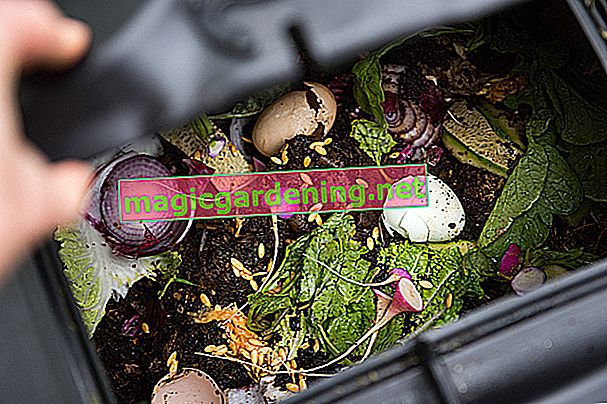
The time window for maggot infestation in the organic waste bin is open from April to October. As long as there are flies, please pay attention to the following measures for effective prevention:
| prevention | done right |
|---|---|
| Cover closed | lockable lid with rubber seal |
| Location | Place in a shady and cool place |
| pack | Meat and fish in compostable bags |
| essential oils | Drizzle over garbage, rub the lid on |
| Newsprint | put between the garbage |
| Cat litter, hay, straw | distribute on the organic waste |
| cleaning | Clean with a high pressure cleaner |
| Sink | Sink the bio bin in the ground |
Experts agree that there is no such thing as complete prevention against pinworms in the organic waste bin. A sensible combination of various preventive measures nevertheless promises maximum success.
Airtight lid
When buying a biowaste bin, look for a lid with a rubber seal. Alternatively, you can simply retrofit the existing barrel lid. The less odor escapes from the organic waste, the less it attracts flies and maggots.
Location

The blazing sun and the associated heat development fuel the creation of lousy maggots in the organic waste bin. If you choose a shady, cool location, this slows down the decomposition process in organic waste. A smart move is a place on the north side of the house. Surrounded by a shadowy hedge, you hide the garbage can in the front garden from the curious glances of passers-by.
Pack properly
Wrap organic waste so that no odor or as little odor as possible escapes. Paper towels, uncoated newspaper or paper napkins are well suited. Please note that so-called compostable organic waste plastic bags are not suitable. Only bags made of paper or corn starch can be used as packaging for meat, fish and fruit leftovers, for the purpose of odor avoidance and maggot prophylaxis.
Essential oils
The intense scent of essential oils has a repellent effect on female flies when approaching. For best results, use citrus oil, tea tree oil, and lavender oil. Every now and then, drizzle a little oil on the organic waste. In addition, put a few drops on a rag and wipe the garbage lid inside and out.
Newsprint, cat litter, hay, straw
Drought is key if you want to avoid maggots in the bio bin. Don't just wrap up suspicious rubbish, but also put newspaper between the garbage bags. Old newspapers and advertising leaflets (not glossy brochures) absorb excess moisture. Alternatively, you can use organic cat litter, hay, straw or sawdust as an intermediate layer to create dry conditions in the organic waste bin.
cleaning
Flies and maggots have an aversion to cleanliness. A sparkling clean organic waste bin is therefore a good preventive measure, because little or no decomposition odor can develop. After each garbage collection, take out the high-pressure cleaner and clean the bin thoroughly inside and out. Wipe with vinegar water. A few drops of essential oil round off the measure.
Sink the bio bin
The luxury version for the prevention of maggots removes the bio-bin from the access of malicious flies. At the push of a button, the electrical system makes the waste bin disappear into the floor under an accessible cover. The bin comes into daylight only for filling and for the rubbish collection appointment. The lift is steplessly controllable, so that children and wheelchair users can easily fill in the garbage. Of course, this level of comfort comes with a price from 3,500 euros.
Tips
Equip your bio bin with a special grub lid. The investment is worth it, because the practical utensil puts an end to nasty maggots and bad smells. The bio filter lid is available in different colors and sizes, suitable for every common bio bin. The filter integrated in the lid must be replaced every two years.
frequently asked Questions
How long does it take for maggots to appear in the bio bin?
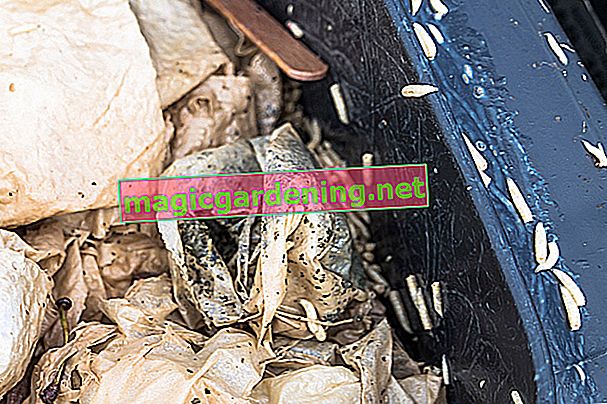
Under ideal conditions with moist heat around 37 ° Celsius, it only takes 30 minutes for a maggot to hatch from a fly egg. At temperatures around 25 ° Celsius, the process takes about 12 hours. Cooler conditions of 18 ° to 23 ° Celsius delay the development of pinworms by another 12 hours. In general, it should be noted that during the warm season between April and October it does not take longer than 24 hours for maggots to appear in a bio bin.
Are maggots dangerous in the bio bin?
The sight of maggots in the organic waste bin causes massive feelings of disgust in most people. Apart from that, the whitish larvae pose no danger. In fact, medical professionals have found that the insect larvae can heal stubborn skin inflammation and serious necrosis. Survival training experts know that maggots are rich in protein and nutrients. Under extreme conditions, consumption can save you from certain starvation.
Are there predators that remove maggots from the organic waste bin?
In fact, maggots are high on the menu of birds. For this reason, the tip is circulating on the internet to leave the bio bin open for some time every day. According to the motto: The enemy of the maggots is the gardener's friend, if birds should take care of the worms in organic waste. However, there are other predators at the inviting buffet, such as rats and mice. Female flies do not miss the opportunity to lay more eggs on the open garbage. Furthermore, it can be doubted that pecking birds can effectively fight an impending maggot invasion.
Can you remove isolated maggots by hand?
Yes, as long as you can bring yourself to picking up maggots. However, we strongly recommend putting on gloves beforehand. Depending on which fly species laid the eggs, hatched larvae can transmit serious diseases. Simple rubber gloves are sufficient to protect against direct skin contact.
Tips
Don't throw away the small, white bags that are in shoe boxes and other product packaging. These silica packets are an excellent means of preventing hideous maggots in the bio bin. Each sachet contains a natural absorbent and ensures dryness in the garbage can, which the larvae do not appreciate at all.








